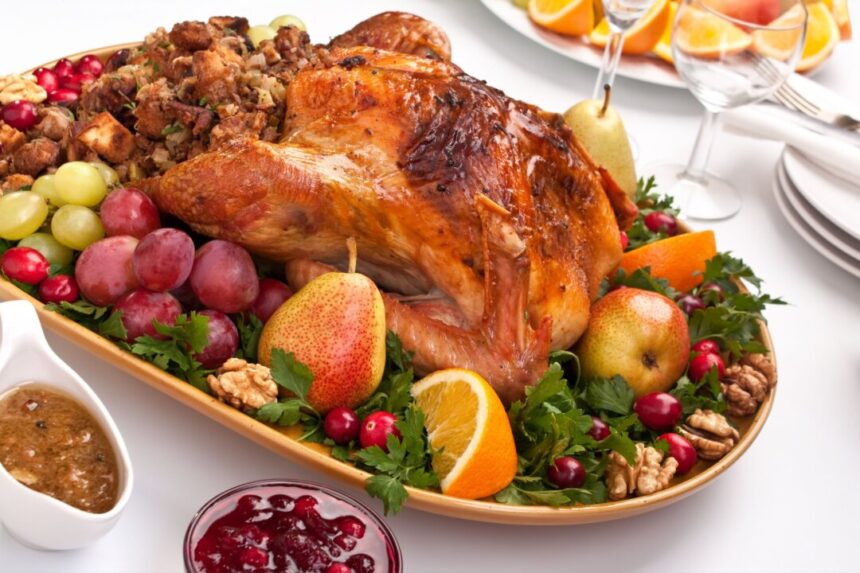Adding fermented food to your Thanksgiving menu can enhance flavor and promote gut health, helping to prevent uncomfortable digestive issues like gas and bloating. Fermenting foods adds probiotics, or beneficial microorganisms, that can aid digestion, improve immunity, and enhance nutrient absorption. Incorporating fermented foods into your meals doesn’t have to be complicated – you can easily find them in stores or make your own at home in just a few days.
Fermented foods, such as yogurt, are not only easy on digestion but also offer numerous health benefits. Yogurt, for example, reduces natural sugars found in milk, making it easier to digest for those with sensitivities. Regular consumption of yogurt has been linked to lower body mass index, reduced risk of Type 2 diabetes, and improved cardiovascular health.
To make your Thanksgiving meals more gut-friendly, consider incorporating fermented foods like yogurt, sauerkraut, or fermented soybeans. These foods not only add interesting flavors to your dishes but also provide a health boost by promoting a diverse community of gut microbes. Probiotic-rich foods can help improve digestion, balance appetite, boost immunity, and increase nutrient absorption.
While fermented foods are traditionally associated with extending the shelf life of food, they also offer significant nutritional benefits. Fermentation enhances the nutritional content of foods, making it easier for our bodies to absorb essential nutrients like calcium and potassium. Additionally, probiotics found in fermented foods aid in the synthesis of important vitamins like B2 and B12, which support energy production and red blood cell formation.
Incorporating fermented foods into your diet can also help with the digestion of hard-to-digest foods like gluten and FODMAPS, which can cause digestive discomfort in some individuals. By adding fermented foods to your Thanksgiving feast, you can support your gut health, improve digestion, and potentially reduce the risk of chronic gastrointestinal issues.
If you missed out on serving fermented foods at Thanksgiving, don’t worry – you can still enjoy the benefits by incorporating them into your leftovers. Turn leftover cranberries into lacto-fermented cranberries or make a Reuben sandwich with sauerkraut and turkey. Remember, it’s never too late to start incorporating fermented foods into your diet, whether you enjoy them with meals or as a snack between meals.
Apple Cider Vinegar Brined Turkey

Turkey made with apple cider vinegar brine. Courtesy of Donna Schwenk
- 1 gallon water, or as needed, divided
- 2 cups apple cider vinegar, with the mother
- 1 cup Kosher salt
- 3 tablespoons peppercorns
- 2 oranges, quartered
- 4 whole bay leaves
Turkey
- 10–12 pound turkey
- Celtic sea salt
- Freshly ground pepper
- 1 bunch fresh or dried thyme
- 1 lemon, halved
- 1 whole onion, peeled and quartered
- 4 tablespoons butter
Apple Cider Brine
- Combine 4 cups water, kosher salt, oranges, and peppercorns together in a large stockpot. Bring to a boil. Cook and stir brine until the salt is just dissolved. Remove from heat, and let cool. Once cooled, add the rest of the water and apple cider vinegar.
- To use the brine, rinse your turkey inside and out. Submerge it into the cooled brine, then add water until the turkey is completely covered and all cavities are filled. Stir around the edges to mix the water with the brine. Refrigerate for a minimum of 12 hours, then remove the turkey from the pot and pat dry with paper towels. Discard the brine and cook the turkey as desired.
Turkey
- Place the turkey in a large roasting pan. Salt and pepper the inside of the turkey cavity. Mix the butter and thyme together with a spoon. Stuff the cavity with the lemon and onion.
- Loosen the skin: Starting at the neck, gently pull the skin away from the meat, being careful not to tear it. This creates pockets for the butter to spread into.
- Use your hands to massage half of the softened butter and thyme mixture under the breast of the skin.
- Brush the outside of the turkey with the rest of the butter mixture and sprinkle with salt and pepper. Tie the legs together with string and tuck the wing tips under the body of the turkey.
- Roast the turkey for 2 ½ to 3 hours, basting from time to time with pan juices or until the juices run clear when you cut between the leg and the thigh. A cooked turkey is considered done when it reaches a minimum internal temperature of 165 degrees F.
- Remove the turkey to a cutting board and cover with foil. Let it rest for 20 minutes. Slice the turkey and serve hot.
2. Einkorn Sourdough Stuffing

Courtesy of Donna Schwenk
Ingredients
- ½ cup butter
- 2 cups celery, chopped
- 1½ cups onion, chopped
- 8 cups einkorn sourdough bread, day old, diced into 1/2 inch cubes
- ¼ cup fresh sage, chopped finely
- 2 tablespoons fresh parsley, chopped finely
- 1 tablespoon fresh thyme, chopped finely
- 3 tablespoons fresh rosemary, chopped finely, stems discarded
- 2 eggs, beaten
- 2½ cups chicken bone broth
- 1 teaspoon coarse Celtic sea salt
- 1 teaspoon black pepper, ground
Directions
- Preheat oven to 350 degrees F. Grease a 9×13 baking dish.
- In a large skillet, melt butter over medium heat.
- Add the leeks, onions, and celery and cook until the onions are softened and the leeks start to become soft, about 7 minutes.
- In a large bowl, mix together bread, onions, celery, and fresh herbs.
- Add half of the chicken broth to the mixture and stir until combined.
- In a small bowl, beat together the eggs and the rest of the chicken broth.
- Add into the mixture a pinch of salt and pepper, and stir until completely combined.
- Pour the stuffing into the prepared baking dish. Add a little more chicken broth, about 1/4 cup, to keep it moist. Cover and bake for 30 minutes. Remove the lid and cook for another 5 minutes until top is slightly browned at the edges.
- Let cool for 5–10 minutes before serving.
Please rewrite the following sentence:
“The cat quickly ran across the street.”
“The feline swiftly sprinted across the road.”
Source link





